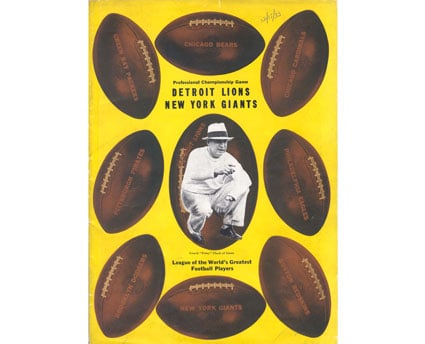Kissing your sister
5/26/2011
A new "For Pete's Sake" blog appears each Thursday.
If you’re an old enough fan, you remember the days when you could invest an entire day at an NFL stadium and drive home without your team winning or losing. Up until an NFL owners meeting in New York that occurred 39 years ago from this past Tuesday, a tie game in the NFL didn’t even count! From the league’s start in 1920 through the ’71 season, a tie game simply was ignored in the winning percentages of teams.
As a historian of the game, I’m not forgetting the other issues on the agenda at that May 1972 meeting such as a proposal on sudden death, a suggested penalty for a quarterback grounding the ball, and the fact that Commissioner Pete Rozelle and the NFL were being sued by the players regarding free agency and compensation.
“We would have hoped that issues relative to employment would be resolved through the process of collection bargaining,” commented Rozelle.
My, how things change (or not)! I think we all agree that we can use a reprieve from the news about the current labor situation in the NFL. So, rather than focus on those issues, let’s return to the subject of the tie.
What’s the big deal about a tie? We all know the phrase about ties that compare them to kissing your sister. Obviously, fans’ complete dislike of tie games was finally addressed by the NFL in 1974 when overtime was instituted for regular season games.
Now, back to the topic at hand which is the change regarding how a tie counts in the standings. There were at least three instances in NFL history where the tie bared its ugly head and ultimately affected the outcome of the league’s champion.
In 1932, the Green Bay Packers quest for their fourth straight league championship was tripped up by the tie. In those years, the NFL title was granted to the team with the best regular season record. The ’32 Packers finished with an impressive 10-3-1 record. In today’s method of counting the tie that winning percentage would have been a healthy .750 but in 1932 it was an even better .769. It didn’t matter.
That’s because the Chicago Bears finished their regularly scheduled games with a 6-1-6 record and the Portsmouth Spartans (now the Detroit Lions) had a record of 6-1-4. In today’s standards that would have placed both teams well behind the Packers in the standings (.692 for the Bears and .727 for the Spartans). But in 1932 the ties were thrown out. So, the Bears and Spartans skyrocketed to 6-1 records for.857 winning percentages. And, with that, the NFL was changed forever. As a result of both teams tying, the NFL decided to schedule a one-game playoff to determine the champion. The historic game resulted in major changes to pro football including significant rule changes, a playoff system, and more. See the story here>>>
It makes one wonder what would have happened had the tie been given some respect!
Three years later the tie again helped the Lions (who by that time had relocated from Portsmouth, Ohio) and once again burned the Packers. Detroit finished with a 7-3-2 mark while Green Bay was 8-4-0. In today’s method of computing win/loss records, the two clubs would have been tied with identical .667 winning percentages and would have faced each other in a one-game playoff to determine the NFL’s Western Division champion. But, throw away the Lions ties and their 7-3-0 record gave them a .700 percentage and a spot in the 1935 NFL Championship Game. Detroit beat the New York Giants in that contest to win their first championship.

A very similar situation occurred in 1949 with the Los Angeles Rams benefiting from the tie not counting as a half-win/half-loss. L.A. went 8-2-2 that season while the Bears finished 9-3-0. Today that means they would have finished with .750 winning percentages. By ignoring the two ties, the Rams won the division crown with a .800 winning percentage. In the end, it may not have mattered as the Philadelphia Eagles shutout the Rams on a muddy L.A. Coliseum field in the title game.
The tie stuck around for many seasons to follow. Other than being an annoyance it really didn’t change the course of NFL history like the scenarios described above. But, it could not be ignored that the tie had to be dealt with by the NFL.
So, the owners convened on May 24, 1972 for the second day of meetings and addressed the issue of the tie’s affect on standings.
“The idea is to make a team play to win, rather than not to lose,” explained a league official.
The Competition Committee proposed Amendment No. 9 to the NFL’s Constitution & Bylaws that changed the wording from “Tie games shall not be considered in calculating percentages,” to “Tie games shall be calculated as one-half game won and one-half game lost.”
Representatives from the Denver Broncos made the motion and were seconded by the Vikings ownership group. The proposal passed unanimously.
Strangely, now four decades later, I actually kind of miss the tie. Maybe it’s just because the tie is such an oddity these days. It’s becomes interesting when on the rare occasion two teams spend an entire week creating a game-plan, practice so hard, and then battle for 75 minutes and yet a winner still can’t be determined!
For the record, the last NFL tie came in 2008 when the Cincinnati Bengals and Eagles played to a 13-13 draw.
Go back to all blog listings

